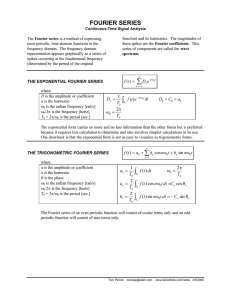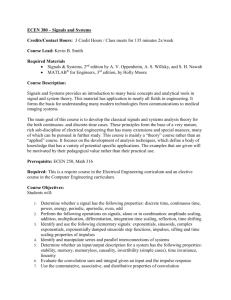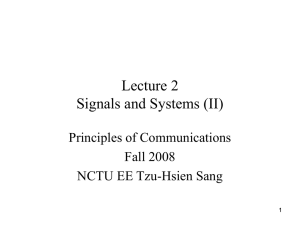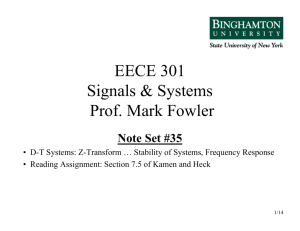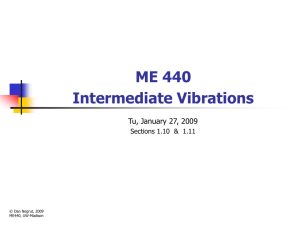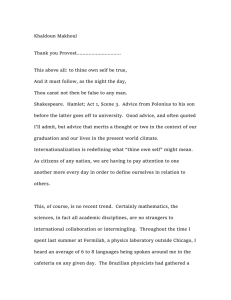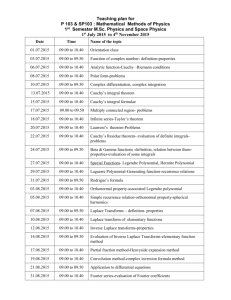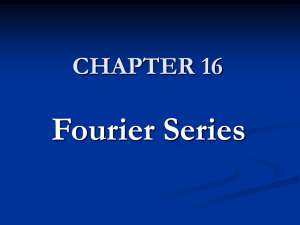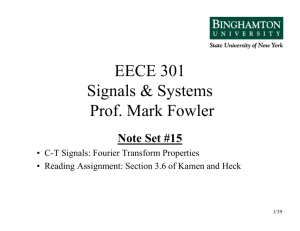EECE 301 Signals & Systems Prof. Mark Fowler
advertisement
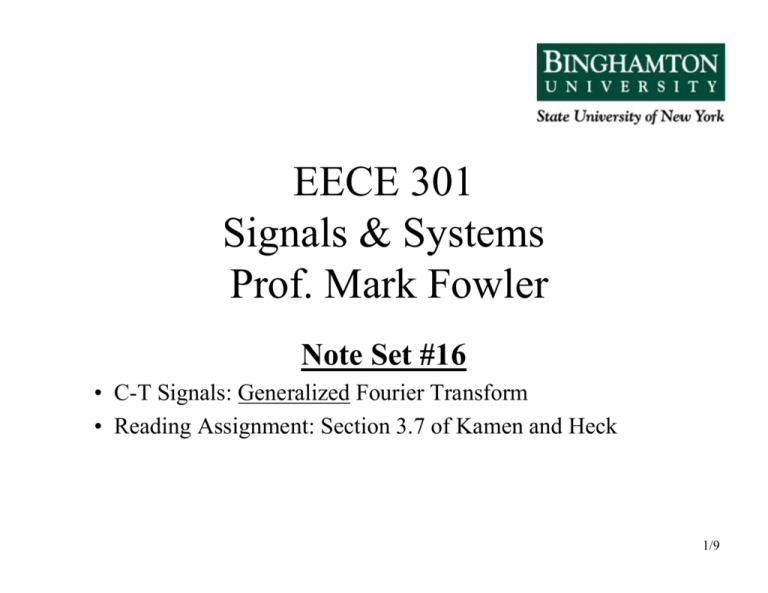
EECE 301
Signals & Systems
Prof. Mark Fowler
Note Set #16
• C-T Signals: Generalized Fourier Transform
• Reading Assignment: Section 3.7 of Kamen and Heck
1/9
Course Flow Diagram
The arrows here show conceptual flow between ideas. Note the parallel structure between
the pink blocks (C-T Freq. Analysis) and the blue blocks (D-T Freq. Analysis).
New Signal
Models
Ch. 1 Intro
C-T Signal Model
Functions on Real Line
System Properties
LTI
Causal
Etc
D-T Signal Model
Functions on Integers
New Signal
Model
Powerful
Analysis Tool
Ch. 3: CT Fourier
Signal Models
Ch. 5: CT Fourier
System Models
Ch. 6 & 8: Laplace
Models for CT
Signals & Systems
Fourier Series
Periodic Signals
Fourier Transform (CTFT)
Non-Periodic Signals
Frequency Response
Based on Fourier Transform
Transfer Function
New System Model
New System Model
Ch. 2 Diff Eqs
C-T System Model
Differential Equations
D-T Signal Model
Difference Equations
Ch. 2 Convolution
Zero-State Response
C-T System Model
Convolution Integral
Zero-Input Response
Characteristic Eq.
D-T System Model
Convolution Sum
Ch. 4: DT Fourier
Signal Models
DTFT
(for “Hand” Analysis)
DFT & FFT
(for Computer Analysis)
Ch. 5: DT Fourier
System Models
Freq. Response for DT
Based on DTFT
New System Model
New System Model
Ch. 7: Z Trans.
Models for DT
Signals & Systems
Transfer Function
New System
Model 2/9
Generalized FT
This section allows us to apply FT to an even broader class of signals that
includes the periodic signals and some other signals.
The trick is to allow the delta function to be a part of a valid FT
But first we start “backwards”… with the delta function in the time domain.
Q: What is the FT of δ(t)?
A: First… think it through! δ(t) is “the narrowest pulse”
And… a narrow pulse has a broad FT…
So… the narrowest pulse should have in some sense the broadest FT
Now… work the math:
3/9
∞
F{δ (t )} = ∫ δ (t )e − jωt dt = e − jω⋅0 = 1
δ(t) ↔ 1
−∞
Sifting property
δ(t)
t
↔
...
1
F{δ(t)} = 1
...
ω
4/9
Now we can use the duality property to get another FT Pair:
δ(t) ↔ 1
1 ↔ 2πδ(ω)
So we now know:
x(t) = 1
...
...
t
↔
“A DC signal” has FT concentrated at 0 Hz
2π
X (ω ) = 2πδ (ω )
ω
DC = 0 Hz
5/9
Now we can get another pair by using this last result and the real
modulation property:
Multiply
by cosine
1 ↔ 2πδ(ω)
Frequency Shift Up & Down
1
cos(ω0t ) × 1 ↔ [2πδ (ω + ω0 ) + 2πδ (ω − ω0 )]
2
F{cos(ω0t)}
ω
-ω0
ω0
Note: This says you only need
the components at +ω0 and -ω0
(i.e., exp{jω0t} and exp{-jω0t})
to build cos(ω0t)
Can do similar thing for sine:
cos(ω0t ) ↔ π [δ (ω + ω0 ) + δ (ω − ω0 )]
sin(ω0t ) ↔ jπ [δ (ω + ω0 ) − δ (ω − ω0 )]
6/9
Similarly… By the complex mod. property:
e
jω 0 t
↔ 2πδ (ω − ω0 )
F{e jω0t }
ω
ω0
Here if
ω0 < 0
Here if
ω0 > 0
Here if
ω0 = 0
Note: This says you need only exp{jω0t} to build exp{jω0t}!!! Duh!!!
7/9
Note that we have now used the FT to analyze cosine and sine… which are
PERIODIC signals!!! Before we used the Fourier Series to analyze periodic
signals… Hmmm… it seems possible to use the FT instead of the FS!!
i.e. the FT subsumes the FS!
FT of periodic signal:
If x(t) is periodic then we can write the FS of it as:
x(t ) =
∞
jkω0t
c
e
∑k
k = −∞
Now we can take the FT of both sides of this:
=
FT of a Periodic Signal
X (ω ) =
∑ 2πc δ (ω − kω )
k = −∞
∞
{
jkω0t
c
F
e
∑k
}
k = −∞
∞
k
⎧ ∞
jkω0t ⎫
F{x (t )} = F ⎨ ∑ ck e
⎬
⎩k = −∞
⎭
2πδ (ω − kω0 )
0
Note: the FT is a bunch of delta functions
with “weights” given by the FS coefficients!
8/9
X (ω ) / 2π
c4
c3
c2
c1
− 4ω0 − 3ω0 − 2ω0 − ω0
c0
c1
c2
c3
c4
ω
ω0 2ω0 3ω0 4ω0
So the FT of a periodic signal is zero except at multiples of the
fundamental frequency ω0, where you get impulses.
We call these spikes “Spectral Lines”
See the book for FT of unit step, which contains a delta function
9/9
